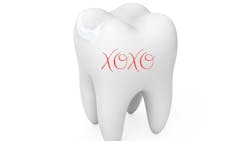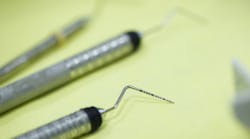Tooth tattoo trend: What dental pros need to know
Body art, especially tattoos, continue to grow in popularity. But did you know that tooth tattoos are now a thing? I’m not just talking about the images that can be placed on a crown during fabrication. Tooth tattoos are images and colorants that are adhered directly to the tooth surface.
Home or pro tattoo kits available to anyone
I came across a company online whose products have me feeling a concern for the public. This company advertises tooth tattoo kits made for both home and professional use. Anyone can buy either one, and they both come with priming gel and bonding resin to attach the image or colorant to the tooth surface. This priming gel is what dental professionals know as etchant.
Here’s a little refresher on what etchant is and what it does to the enamel. Etching of enamel removes a small portion of the surface and opens microscopic porosities.1 Etchant is an acid that microscopically dissolves some minerals in the enamel, causing a roughened surface the bonding resin can lock into.1,2 Think Velcro. The bonding resin is then light cured, and it locks into the microscopic spaces and irregularities.1,2
The company posts videos on its website about how to apply the images. It involves using etchant to prepare the tooth surface, and then attaching the image or colorant via bonding resin and a curing light. For those at home, the website provides a warning label stating that complete removal of the product may require the help of a dental professional, and that tooth sensitivity may occur.
The professional kit is even more alarming. These are meant to be more permanent versus temporary. There are videos about how to apply and remove the images and colorant. Removal involves using a handpiece and bur, much like removing resin for orthodontic brackets.
Not only is a small portion of the enamel being removed and demineralized during the etchant process,1,2 but if the images or colorant require removal by a dental professional using a rotary instrument, even more enamel will be removed.3-6
There have been many studies done since the start of the technique attesting to the fact that removal of fixed orthodontics causes irreversible damage to the enamel. Debonding removes a portion of the enamel and roughens the surface, which then needs to be smoothed down further to prevent increased stain and plaque accumulation.3-6
Do your homework
I encourage you to do a quick online search of tooth tattoo products and watch the available how-to videos. My jaw hit the floor while I watched one video, in which a handpiece and bur is taken out to remove the colorant placed on the entire facial surface of the person’s maxillary central incisor. This product is a concern for application on healthy enamel, but what about people trying to place these images on unhealthy teeth with exposed dentin, active decay, or restorations?
They could cause extreme sensitivity in the tooth or destroy an expensive tooth restoration. The website does have warning labels, but is this enough? As dental professionals, we need to be aware of new products that become easily available to our patients so we can educate them on the effects of some of these products. Through social media, people are bombarded with product ads. Many of these products don’t have to be FDA or ADA accepted to be available.
Tips for educating patients about concerning products
- Explain the process of how the products work.
- Explain the possible side effects of the products.
- Display and make educational pamphlets available in the dental office that explain what tooth art is and what precautions to take.
- Explain the FDA and ADA seal of acceptance and how to determine if a product has been tested and accepted.
References
1. Eakle WS, Bastin KG. Dental materials: Clinical Applications for Dental Assistants and Dental Hygienists. 2019. Saunders.
2. Acid etching: how does it work? Colgate. January 9, 2023. https://www.colgate.com/en-us/oral-health/bonding/acid-etching-how-does-it-work
3. Janiszewska-Olszowska J, Szatkiewicz T, Tomkowski R, Tandecka A, Grocholowicz K. Effect of orthodontic debonding and adhesive removal on the enamel: current knowledge and future perspectives—a systematic review. Med Sci Monit. 2014;20(10):1991-2001. doi:10.12659/MSM.890912
4. Swaroop D, Brahmani K, Singaraju GS, et al. A comparative evaluation of enamel surface roughness of two different bonding adhesives after debonding with atomic force microscopy. Cureus. 2022;14(11):e31661. doi:10.7759/cureus.31661
5. van Waes H, Matter T, Krejci I. Three-dimensional measurement of enamel loss caused by bonding and debonding of orthodontic brackets. Am J Orthod Dentofacial Orthop. 1997;112(6):666-669. doi:10.1016/s0889-5406(97)70232-4
6. Pus MD, Way DC. Enamel loss due to orthodontic bonding with filled and unfilled resins using various clean-up techniques. Am J Orthod. 1980;77(3):269-283. doi:10.1016/0002-9416(80)90082-2
About the Author

Lindsey Billing, MEd, BS, RDH
Lindsey Billing, MEd, BS, RDH, has practiced for 13 years in Indianapolis, Indiana. She has worked at a periodontal practice since licensure and is a Clinical Assistant Professor at the Indiana University School of Dentistry, dental hygiene program. She teaches the Periodontics and Dental Materials courses and is the clinical course director for the third-year dental hygiene students.




